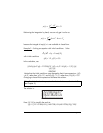
Page 16-14
Θ Shift theorem for a shift to the right. Let F(s) = L{f(t)}, then
L{f(t-a)}=e
–as
⋅L{f(t)} = e
–as
⋅F(s).
Θ Shift theorem for a shift to the left
. Let F(s) = L{f(t)}, and a >0, then
Θ Similarity theorem
. Let F(s) = L{f(t)}, and a>0, then L{f(a⋅t)} = (1/a)⋅F(s/a).
Θ Damping theorem
. Let F(s) = L{f(t)}, then L{e
–bt
⋅f(t)} = F(s+b).
Θ Division theorem
. Let F(s) = L{f(t)}, then
Θ Laplace transform of a periodic function of period T
:
•
Limit theorem for the initial value: Let F(s) = L{f(t)}, then
•
Limit theorem for the final value: Let F(s) = L{f(t)}, then
Example 4
– Using the convolution theorem, find the Laplace transform of
(f*g)(t), if f(t) = sin(t), and g(t) = exp(t). To find F(s) = L{f(t)}, and G(s) = L{g(t)},
use: ‘SIN(X)’ ` LAP μ. Result, ‘1/(X^2+1)’, i.e., F(s) = 1/(s
2
+1).
Also, ‘EXP(X)’ ` LAP. Result, ‘1/(X-1)’, i.e., G(s) = 1/(s-1). Thus, L{(f*g)(t)} =
F(s)⋅G(s) = 1/(s
2
+1)⋅1/(s-1) = 1/((s-1)(s
2
+1)) = 1/(s
3
-s
2
+s-1).
{}
==−
∫
)})(*{()()(
0
tgfduutguf
t
LL
)()()}({)}({ sGsFtgtf ⋅=⋅LL
.)()()}({
0
⎟
⎠
⎞
⎜
⎝
⎛
⋅⋅−⋅=+
∫
−
a
stas
dtetfsFeatfL
∫
∞
=
⎭
⎬
⎫
⎩
⎨
⎧
s
duuF
t
tf
.)(
)(
L
∫
⋅⋅⋅
−
=
−
−
T
st
sT
dtetf
e
tf
0
.)(
1
1
)}({L
)].([lim)(lim
0
0
sFstff
st
⋅==
∞→→


















